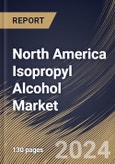The market is a vital component within the chemical industry, resonating with multifaceted applications across various sectors. From pharmaceuticals to electronics, cosmetics to automotive, the ubiquity of this underscores its indispensability in modern manufacturing and everyday life. As a clear, colorless liquid with a distinctive odor, isopropyl alcohol, also known as isopropanol, embodies versatility, efficiency, and reliability, making it a linchpin in numerous industrial processes and consumer products.
Moreover, the market dynamics for this is akin to a complex pattern made of demand, supply, manufacturing, and regulation. With its origins rooted in the chemical synthesis of propylene or the hydrogenation of acetone, the production of its traverses’ diverse technological pathways, each bearing its unique imprint on market dynamics. From traditional manufacturing processes to cutting-edge innovations in sustainable production, the evolution of this production reflects the industry's commitment to efficiency, safety, and environmental stewardship.
The growth of the cosmetics industry in Mexico can exert considerable influence on the market by driving demand, influencing supply chain dynamics, affecting pricing, and shaping regulatory considerations. Mexico's cosmetics and personal care products industry was estimated to be worth USD 7.24 million in 2022. Mexico is ranked among the top 10 for cosmetics and personal care products. The value of Mexico's cosmetics and personal care product exports in 2022 was USD 2.2 billion. Therefore, the expansion of cosmetics and personal care industry is driving the growth of the market.
The US market dominated the North America Isopropyl Alcohol Market by Country in 2022, and would continue to be a dominant market till 2030; thereby, achieving a market value of $768.9 million by 2030. The Canada market is experiencing a CAGR of 9.2% during (2023 - 2030). Additionally, The Mexico market would exhibit a CAGR of 8.6% during (2023 - 2030).
Based on Application, the market is segmented into Antiseptic & Astringent, Cleaning Agent, Chemical Intermediate, Solvent, and Others. Based on End Use, the market is segmented into Pharmaceutical, Cosmetics & Personal Care, Food & Beverage, Paints & Coatings, Electronics, Chemicals, and Others.Based on countries, the market is segmented into U.S., Mexico, Canada, and Rest of North America.
List of Key Companies Profiled
- The Dow Chemical Company
- LyondellBasell Industries Holdings B.V.
- Huntsman Corporation
- Ecolab, Inc.
- Exxon Mobil Corporation
- INEOS Group Holdings S.A.
- LG Chem Ltd. (LG Corporation)
- Linde plc
- Shell plc
- Mitsubishi Chemical Holdings Corporation
Market Report Segmentation
By Application (Volume, Kilo Tonnes, USD Billion, 2019-2030)- Antiseptic & Astringent
- Cleaning Agent
- Chemical Intermediate
- Solvent
- Others
- Pharmaceutical
- Cosmetics & Personal Care
- Food & Beverage
- Paints & Coatings
- Electronics
- Chemicals
- Others
- US
- Canada
- Mexico
- Rest of North America
Table of Contents
Companies Mentioned
- The Dow Chemical Company
- LyondellBasell Industries Holdings B.V.
- Huntsman Corporation
- Ecolab, Inc.
- Exxon Mobil Corporation
- INEOS Group Holdings S.A.
- LG Chem Ltd. (LG Corporation)
- Linde plc
- Shell plc
- Mitsubishi Chemical Holdings Corporation








